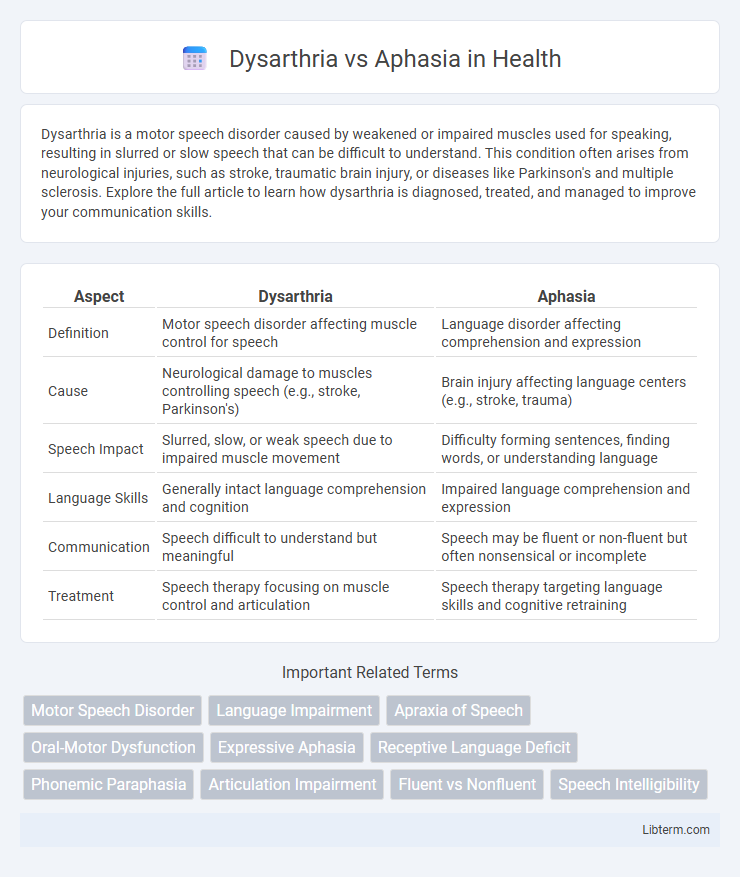Dysarthria is a motor speech disorder caused by weakened or impaired muscles used for speaking, resulting in slurred or slow speech that can be difficult to understand. This condition often arises from neurological injuries, such as stroke, traumatic brain injury, or diseases like Parkinson's and multiple sclerosis. Explore the full article to learn how dysarthria is diagnosed, treated, and managed to improve your communication skills.
Table of Comparison
| Aspect | Dysarthria | Aphasia |
|---|---|---|
| Definition | Motor speech disorder affecting muscle control for speech | Language disorder affecting comprehension and expression |
| Cause | Neurological damage to muscles controlling speech (e.g., stroke, Parkinson's) | Brain injury affecting language centers (e.g., stroke, trauma) |
| Speech Impact | Slurred, slow, or weak speech due to impaired muscle movement | Difficulty forming sentences, finding words, or understanding language |
| Language Skills | Generally intact language comprehension and cognition | Impaired language comprehension and expression |
| Communication | Speech difficult to understand but meaningful | Speech may be fluent or non-fluent but often nonsensical or incomplete |
| Treatment | Speech therapy focusing on muscle control and articulation | Speech therapy targeting language skills and cognitive retraining |
Understanding Dysarthria and Aphasia
Dysarthria is a motor speech disorder caused by neurological damage affecting the muscles used for speaking, resulting in slurred or slow speech that can be difficult to understand. Aphasia, on the other hand, is a language disorder affecting the brain's ability to comprehend or produce language, often caused by stroke or brain injury, leading to difficulties in speaking, reading, writing, or understanding language. Understanding these distinctions is crucial for accurate diagnosis and targeted speech therapy interventions.
Definition of Dysarthria
Dysarthria is a motor speech disorder characterized by impaired articulation caused by neuromuscular weakness or incoordination affecting the vocal apparatus, including the lips, tongue, vocal cords, and diaphragm. Unlike aphasia, which involves disruptions in language processing and comprehension due to brain damage, dysarthria specifically impacts speech production and clarity. This condition often results from neurological injuries such as stroke, traumatic brain injury, or progressive diseases like Parkinson's disease.
Definition of Aphasia
Aphasia is a language disorder resulting from brain damage that impairs the ability to communicate effectively through speech, writing, or comprehension. Unlike dysarthria, which affects the motor control of speech muscles, aphasia disrupts the cognitive processes involved in language formation and understanding. This condition commonly arises from stroke, traumatic brain injury, or neurological diseases impacting the language centers of the brain, such as Broca's or Wernicke's areas.
Causes of Dysarthria
Dysarthria is primarily caused by neurological damage affecting the muscles used for speech, such as brain injury, stroke, Parkinson's disease, or multiple sclerosis. This condition results from impaired motor control due to lesions in the central or peripheral nervous system, disrupting the coordination of speech muscles. Unlike aphasia, which stems from language processing deficits in the brain, dysarthria specifically involves muscle weakness or paralysis impacting speech production.
Causes of Aphasia
Aphasia results primarily from brain damage in areas responsible for language processing, most commonly the left hemisphere, including Broca's and Wernicke's areas. The leading causes include ischemic or hemorrhagic stroke, traumatic brain injury, brain tumors, and neurodegenerative diseases such as Alzheimer's. Understanding the specific etiology of aphasia aids in targeted treatment plans and improves prognosis compared to dysarthria, which mainly involves motor speech impairments caused by neurological conditions affecting muscle control.
Key Differences Between Dysarthria and Aphasia
Dysarthria is a motor speech disorder characterized by impaired muscle control affecting the production of speech, whereas aphasia is a language disorder impacting the ability to understand or formulate language. Dysarthria primarily involves difficulties in articulation, phonation, and respiration, while aphasia affects semantics, syntax, and language comprehension. Key distinctions include the intact language cognition in dysarthria contrasting with aphasia's impairment in language processing and communication.
Common Symptoms and Signs
Dysarthria is characterized by slurred or slow speech due to muscle weakness affecting articulation, resulting in difficulty pronouncing words clearly and changes in voice quality, such as hoarseness or breathiness. Aphasia primarily involves language impairment, causing problems with speaking, understanding, reading, or writing, often marked by word-finding difficulties, jumbled or nonsensical sentences, and impaired comprehension. Both disorders can coexist but differ as dysarthria affects motor speech production, whereas aphasia disrupts language processing in the brain.
Diagnosis and Assessment Methods
Dysarthria diagnosis primarily involves clinical speech evaluation focusing on motor speech control, including assessments of muscle strength, coordination, and reflexes using tools like the Frenchay Dysarthria Assessment. Aphasia assessment centers on language comprehension and production abilities, employing standardized tests such as the Boston Diagnostic Aphasia Examination and the Western Aphasia Battery to analyze speech fluency, naming, repetition, and auditory comprehension. Neuroimaging techniques like MRI and CT scans support differential diagnosis by identifying underlying neurological damage associated with each disorder.
Treatment Approaches for Dysarthria vs Aphasia
Treatment approaches for dysarthria primarily involve speech therapy targeting muscle strength, coordination, and articulation to improve speech clarity, often including exercises, augmentative and alternative communication (AAC) devices, and respiratory support techniques. Aphasia treatment emphasizes language therapy that focuses on improving comprehension, expression, reading, and writing skills through methods like constraint-induced language therapy, melodic intonation therapy, and individualized communication strategies. Both conditions benefit from multidisciplinary interventions involving speech-language pathologists but require distinct therapeutic goals due to dysarthria's motor speech impairment and aphasia's language processing deficits.
Living With Dysarthria or Aphasia: Support and Resources
Living with dysarthria or aphasia requires tailored communication support and specialized therapy to enhance speech clarity and comprehension. Access to speech-language pathologists, support groups, and adaptive communication devices plays a crucial role in improving daily interactions and quality of life. Online platforms and community organizations provide valuable resources, fostering connection and empowerment for individuals managing these speech disorders.
Dysarthria Infographic

 libterm.com
libterm.com